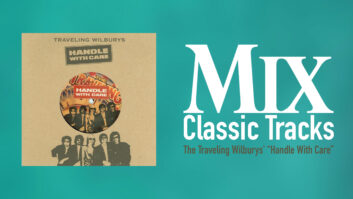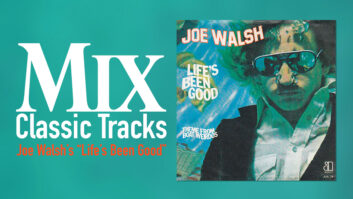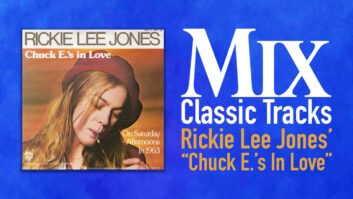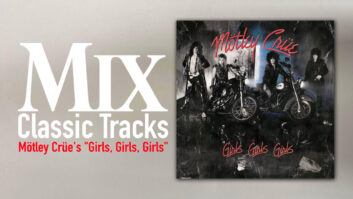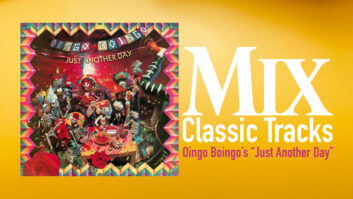After George Harrison’s mellow Gone Troppo album bombed upon its release in 1982, the former Beatle all but announced his retirement from the music business, noting that he was going to concentrate on his burgeoning film operation instead. Beginning in 1979, his HandMade Films company helped produce such movies at Monty Python’s Life of Brian, The Long Good Friday, Time Bandits, The Missionary, Mona Lisa and others.
It was working on the soundtrack for HandMade’s most notorious “catastrophe” (as he called it)—the 1986 Madonna/Sean Penn film Shanghai Surprise—that first brought engineer Richard Dodd to the recording studio in Harrison’s 120-room mansion known as Friar Park, in Henley-on-Thames, west of London in Oxfordshire. Harrison wrote a few songs for the film (and appeared briefly in a nightclub scene) and worked closely with composer Michael Kamen on the incidental music.

“Actually, the first time I worked with George was in ’78 when I did string overdubs for him at AIR London for an album he was doing [called George Harrison],” Dodd recalls from his Nashville home. “Then, nothing, until George called a producer I was working with, Mike Moran, who does film music. George was executive producer on Shanghai Surprise and doing the music with Michael Kamen, and Michael brought his engineer to George’s studio and apparently he and George didn’t hit it off. Plus, they wanted to lock picture to sound in this private studio, which was still very complicated in those days. I knew how to do it, so Mike said, ‘You need Richard.’ So I moseyed on over there, and unlike the previous engineer, I didn’t complain about the equipment. I just got on with it.”
Dodd was already a seasoned veteran by this time, having engineered and/or produced many acts since the early ’70s, including Leo Sayer, Clannad and the Little River Band. But getting the call to work with Harrison was certainly a major career step for him. And nothing could have prepared him for the wonderland that was Friar Park: The exotic 19th-century “French Flamboyant Gothic” estate sat on sprawling grounds that included a lake, ponds, underground grottos and caves, cascading waterfalls, meadows, narrow ravines, topiary gardens, a Japanese garden, an Elizabethan garden and even a huge sandstone replica of the Matterhorn built by Friar Park’s eccentric late-19th/early 20th-century owner, a successful barrister named Frank Crisp, immortalized in Harrison’s “The Ballad of Sir Frankie Crisp (Let It Roll)” on his Phil Spector-produced masterpiece All Things Must Pass. When Harrison bought the mansion in 1970, it had been owned for many years by an order of nuns, and both the buildings and grounds had gone into decline. He personally restored and designed new gardens—it became his obsession—and also did extensive work on the interior of the palatial home, including putting in a home recording studio on the upper level of one wing during 1971-’72.
“FPSHOT,” as it was listed on album covers (for “Friar Park Studio Henley-on-Thames”), was designed by Eddie Veale. Veale also built a personal recording studio for John Lennon a little earlier; that’s the Ascot studio where Lennon’s Imagine album was cut. Veale had been involved with the London studio scene since the mid-’60s, designing monitor systems, consoles and other gear for Advision, and then branching out from there as an independent. (He still runs the design and acoustics consultancy Veale Associates.)
“George had very clear ideas about what he wanted for his studio,” Veale says. “It was part of his home, so it was to be ‘homey,’ and in context to the property. The décor had to fit in with and complement the style of the building, and achieve a high technical/acoustical standard. Much of the design work was done in 1971 and, apart from a wall fabric change, all remains as originally constructed.”
As for the studio’s custom console, “We started designing at the end of 1971 and installed October 1972,” Veale continues. “George wanted to have the use of the mix section and leave the recording to the preserve of the engineer. I designed the console as a split 48-channel—24 record inputs and 24 mix inputs—plus auxiliaries. The 24 mic inputs, on the right-hand section, were switchable to two line inputs for a second machine for 48-track mixing. The center section was the 24-track mix section, switchable between three line inputs to cater for different machine combinations. Most of the console modules were built for me by Cadac, and I selected from their range of amplifiers, equalizers, et cetera, for inclusion. I used the top end of their range with some adaptation to the EQ to make it George-friendly. Monitoring was based on the Altec system George loved at EMI Studios—as were the faders—plus a variety of options.”
Fast-forward again to 1986 and Shanghai Surprise. Harrison found working on the songs for that film sufficiently fun and stimulating that, according to Dodd, “George said, ‘I’m thinking about doing a solo album. Would you like to be the engineer?’ It didn’t take me long to say yes. Then he said, ‘I’ve got an American producer and we’ll see how it goes.’” Dodd prefers not to mention the producer’s name, as neither the engineer nor Harrison seemed to like the producer’s approach to recording, and after starting three songs, Harrison did not bring the producer back for more work. Instead, as he told Dodd, “‘I’ve got somebody else coming in to see if I can get him to work with me.’ I found out that was Jeff Lynne.
“I don’t know how keen Jeff was to produce somebody else,” Dodd continues, “but he was certainly keen to meet and hang with George. When George played him what we’d done [with the other producer,] Jeff was looking at me like, ‘You’re crap.’ George said, ‘What do you think?’ And Jeff quite politely said, ‘Not the way I would have done it.’ And out of the side of my mouth I said, ‘Not the way I would’ve done it, either.’ We called it a day and he and George hung out for the evening and got used to each other, and the next time I came back to work, Jeff was ready to start. And that was a little awkward because Jeff thought he had to use me—he thought I was George’s engineer and he was stuck with me. Jeff said, ‘I don’t like things to sound like that,’ and this time I really did say out loud, ‘Nor do I!’ He said, ‘What do you mean?’ I said, ‘That’s the way the other guy liked it, it’s not how I would do it.’ And I described my method and he said, ‘Well, that’s the way I like to do it.’ And from then on we got on quite well.”
Though Lynne has become a well-known producer since these Harrison sessions that eventually became the smash Cloud Nine album, before they hooked up, Lynne had mainly worked as a jack-of-all-trades singer/composer/multi-instrumentalist/producer for his group The Move, which morphed into the extremely popular Electric Light Orchestra. Harrison told Mix writer Bruce Pilato in a 1987 interview: “I was afraid to get some producer who would make my album full of gated, reverb’d snare drums and DX7s because I’m sick of that. I’m just not into that at all. It had to be someone who would take the best of the past and whatever I could do and put it in the ‘now.’
“[Jeff has] got a good ear and uses good discrimination in his choice of sounds and instruments. At the same time, his favorite music is basically all the old stuff, all the old chords from old pop music. I’ve always thought that since the early ’70s that Electric Light Orchestra…had taken off from where The Beatles were at with ‘I Am the Walrus’ and those sort of things, particularly the cellos. He made all this ELO music that was sort of like a continuation, in a way, of all the stuff that we’d done. We have similar likes and dislikes, and we’re both guitar players, as well.”
Dodd says that Lynne had no hesitation in asserting himself either musically or technically—he was intimately involved with arrangements, played all sorts of different instruments, co-wrote a couple of tunes and “was very knowledgeable about tone-shaping and dynamic-shaping equipment.” As Harrison had on earlier solo efforts, for Cloud Nine, he enlisted a handful of his favorite musicians to help out—including Eric Clapton on guitar; Elton John and Gary Wright on piano; Jim Keltner, Ringo Starr and Ray Cooper on drums and percussion; and Jim Horn on saxophones. Lynne handled bass, other guitars, keyboards and backing vocals. The goal was to make a record that was free of artifice and that sounded like it was made by a band.
This month’s “Classic Track,” “Got My Mind Set on You” is a bit of an anomaly in that it is the only song on Cloud Nine that was not written or co-written by Harrison, and it was also constructed in the studio in a somewhat unusual way.
Today, R&B singer James Ray (1941-1964) is mostly remembered for his one hit song: the 1962 Rudy Clark-penned number, “If You Gotta Make a Fool of Somebody,” which was a big hit in the U.S. and also popular in England; The Beatles even performed it in their early days. “Got My Mind Set on You” was also written by Rudy Clark (best known for “Good Lovin’” and “It’s In His Kiss”) and recorded by Ray in 1962. But it was never a hit. However, Harrison bought the single on his first trip to America and the song stuck with him through the years.
Dodd recalls that “Got My Mind Set on You” was cut a few songs into the sessions for Cloud Nine. Jim Keltner had flown in from New York and showed up at Friar Park with a cassette of some roomy, ambient drum sounds and patterns he’d worked up for that song over the course of three days at Power Station. “He said, ‘I’d like to get that sound for George,’” Dodd recalls. “I said, ‘That’s going to be difficult here. Other than the stairwell, there’s nothing I can think of that has the ambience of that room at Power Station.’” When Keltner saw a never-before-used E-mu Drumulator in Harrison’s studio, he and Dodd conspired to get the drum sounds from the cassette into the drum machine so they could show Harrison the sound they wanted.
“I think the maximum storage time in this Drumulator—which had 7-inch bendable floppy discs—was half-a-second per sound,” Dodd says. “I grabbed a kick and a snare from the tape and [the Drumulator] had an onboard generic hi-hat as a built-in sound so we used that.” In addition, Keltner played a four-bar loop of the drum part.
“We played it for George, and he said, ‘Yeah, let’s do a demo.’ So we put that down on tape—I think we put down five minutes of it. Later on, Jeff arrived and saw what we were doing and we talked about it. Usually, depending on the song, it would be a DI Telecaster either from George or Jeff that we’d put down as a guide; sometimes with an [Oberheim] OB-X pad with Jeff. In this case, the piano wasn’t in tune so I suggested putting on an [E-mu] Emulator II, which had a decent piano sound, as a guide, and so they went and did that. Jeff would always stick a bass on.
Classic Track: T. Rex’s “Bang A Gong (Get It On)”
“This was only a demo, right? Well, we put a guide voice on it and it evolved from there. Jim Horn came in and made a slave of his saxophones and we slid them in manually. Same thing for the backing vocals—Jeff and George would sing backups together. Then I pointed out we needed to put the real piano on and the real drums. By then, though, everyone was used to what they were hearing and so that was it. The final drum patterns were done later during the mix with delays and mute switches—no automation.”
In addition to the famous custom console, in 1987 FPSHOT was equipped with a Studer A80 24-track recorder with Dolby built into a custom Eddie Veale-designed rack above the machine. “George hated the smell of Ampex tape,” Dodd says, “so everything was done to Scotch 250 unless circumstances dictated otherwise.” The studio had a large complement of Neumann mics, and Dodd notes that for the Cloud Nine sessions, he employed mostly U67s, U87s and KM84s for nearly everything. (Kick would be a 67, overheads 87s.) Harrison sang his lead vocals into an 87 in the control room, usually wearing headphones and with the monitors turned down low. In that era, the studio had built-in Altec 604Es as mains and Tannoy Little Reds for near-fields. Processing (besides the in-board pre’s and EQ) included a Fairchild, AMS DDL, a pair of 1176s, a GML mic pre and other pieces.
“Got My Mind Set on You” and the Cloud Nine album in general, are notable for the creamy background vocals by Harrison and Lynne that are clearly Beatles-influenced but actually sound more like ELO. Typically, Dodd would stack up to nine vocal parts to achieve the desired effect: “Sometimes we triple-tracked, sometimes we quadruple-tracked. If there’s more than one voice, we would rarely do more than three tracks per part. The more we did it, though, the less George wanted to do. He was happy enough with one or two tracks, but Jeff wanted to even out some of the pitching issues, which, to be polite, were never Jeff. Not that George sang out of tune; he just wasn’t perfect like Jeff.” Some of the backup vocals were looped and flown into different parts of the song.
Warner Bros. flipped over the finished album and instantly chose the catchy “Got My Mind Set on You” as the first single. It went all the way to Number One in the U.S.; in fact, it was the last single by a former Beatle to top the charts.
Lynne, Harrison and Dodd would go on to make a couple of albums with the all-star Traveling Wilburys in L.A. (and both Lynne and Dodd have had fantastically varied careers since), but Cloud Nine would be the last album Harrison released before his death in November 2001. (The excellent CD Brainwashed was completed posthumously.)
